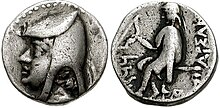Parthian currency
The Parthian currency is one of the most important sources on the history and culture of the Parthian Empire . The Parthian coin system was based on the Attic coin standard . Mainly tetradrachms and drachms , but also other silver and bronze coins were minted.
On the obverse there is usually a picture of the Parthian king in profile, more rarely also in front view. Until Mithridates II. (Approx. 124 / 23–88 / 87 BC) it showed portrait-like features, but was then increasingly stylized. Since that time, different crowns have appeared, by which the rulers can be distinguished. However, these crowns are not as individually designed as on the Sassanid coins. On the lapels there is usually an image of an archer and on the tetradrachms the year after the Seleucian era and monograms of the minting places. Overall, the reverse shows little change, which is in contrast to the simultaneous coinage of the Roman Empire. The Parthian coinage has this in common with almost all of the Hellenistic world.
When the Parthians invaded the Seleucid Empire , they found a fully developed coin system and were certainly confronted early on with the task of creating their own monetary system in order to guarantee a functioning economy. However, it is uncertain when the Parthians began to mint their own coins. Mithridates I certainly minted coins. He is also considered the actual founder of the Parthian Empire and was able to conquer large parts of the Seleucid Empire. Important mints such as Ekbatana , Seleukia and Susa were conquered under him. There are some coins that may be attributed to Arsakes I and Arsakes II , but do not bear any legends. The place of minting is unknown, but Nisa is suspected.
With the consolidation of the Parthian Empire under Mithridates II (approx. 124 / 23–88 / 87 BC) the Parthian coin system was fully developed. The mints were under state control, although there were various mints that did not work uniformly. In addition, some local dynasties, such as the Charakene , Elymais and Persis , minted their own coins. The Greek cities of Seleukia and Susa also launched their own city issues. Since the middle of the first century BC, Parthian coins in north-eastern Iran have been counter-marked. Parthian coins were probably used locally, while the counter marks signal a certain independence of local princes. Own coins are minted in the margiane . Above all, the emissions from Sanabares should be mentioned here, which mostly consist of pure copper.
Since the middle of the first century BC, a deterioration in the silver content of the coins in the Charakene and Elymais has been observed, giving their coins a local character, while deteriorations in the silver content of the imperial coins can only be observed later. Overall, the development meant that the various Parthian coins were only used locally. The discovery of Parthian coins in a coin hoard from Iberia is certainly an exception.
literature
- Michael Alram: Status and tasks of the arsakid Numismatics , In: Josef Wiesehöfer (Hg): The Parthian Empire and its testimonies. Contributions from the international colloquium, Eutin (June 27-30, 1996) = The Arsacid Empire. Sources and documentation . Steiner, Stuttgart 1998, ISBN 3-515-07331-0 , ( Historia , individual writings 122), ISSN 0341-0056 , pp. 365-387.


